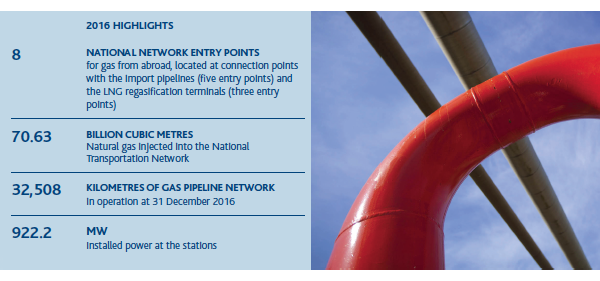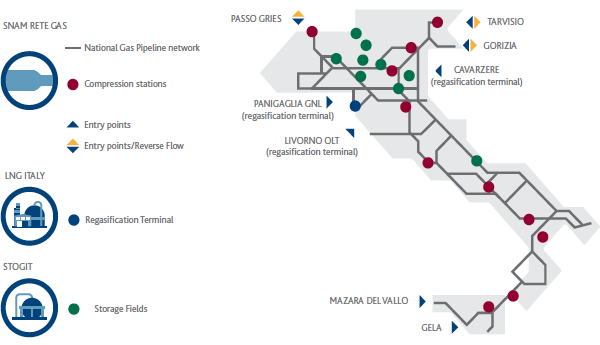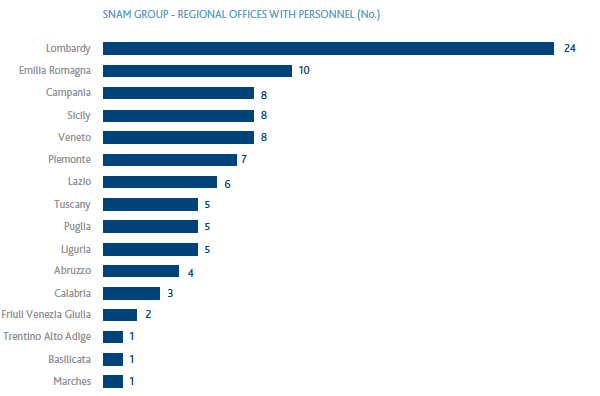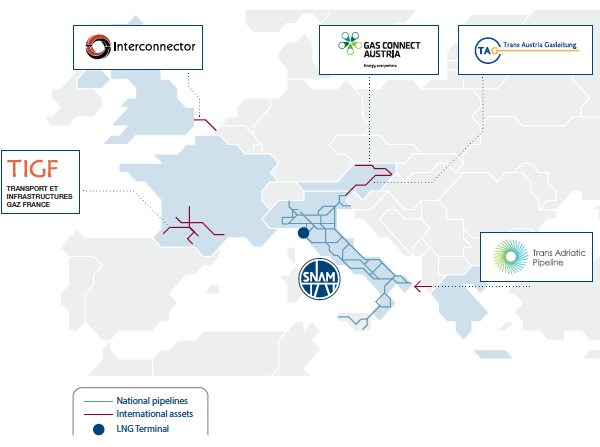Snam’s presence in Italy and Europe
Snam’s role in the Italian gas system
Business segments
As an integrated operator in the natural gas infrastructure system, Snam is active in the following business segments:
TRANSPORTATION AND DISPATCHING
Snam Rete Gas is the leading Italian natural gas transportation and dispatching operator, and owns almost all of the transportation infrastructure in Italy, with 32,508 km of high- and medium-pressure gas pipelines (approximately 94% of the entire transportation system).
Snam Rete Gas manages the gas pipeline network via 8 districts, 48 maintenance centres throughout Italy, 11 compression stations and a new dispatching unit that has been extensively renovated in terms of structure and technology.
The gas from abroad is injected into the National Network via entry points where the network joins up with the import methane pipelines (Tarvisio, Gorizia, Gries Pass, Mazara del Vallo and Gela) and with the LNG regasification terminals (Panigaglia, Cavarzere and Livorno). Once it has been imported or regasified, the gas is transported to the local distribution networks, the regional network redelivery points or large end users such as thermoelectric power stations or manufacturing plants.
Snam Rete Gas awards transportation capacity to applicant shippers. The service access conditions are contained in the Network Code, which is updated based on criteria laid down by the Authority.

REGASIFICATION
The terminal at Panigaglia (La Spezia), which is owned by the subsidiary GNL Italia, was the first regasification plant built in Italy. It has a daily regasification capacity of 17,500 cubic metres of LNG, and can therefore, at maximum operating capacity, inject 3.5 billion cubic metres of natural gas into the transportation network every year.
The process for the extraction of natural gas from the deposits, its liquefaction for transportation by ship and the subsequent regasification for use by the users, forms the ‘LNG chain’. The process begins in the country of the exporter, where the natural gas is brought to a liquid state by cooling it to -160 °C and subsequently loaded onto tankers for shipping to the LNG regasification terminal. At the regasification terminal, the LNG is unloaded, then heated and returned to a gaseous state before being injected into the natural gas transportation network. The regasification service includes unloading the LNG from the vessel and operating storage, i.e. the storage time required for vaporising the LNG, regasifying it and injecting it into the National Network.

STORAGE
Stogit is the major storage operator in Italy and one of the largest in Europe, with 12.0 billion cubic metres of available capacity (approximately 94% of the available space throughout Italy) and 4.5 billion cubic metres of strategic storage space.
The natural gas storage business in Italy is carried out under a concession regime and it serves to offset the various demands of gas consumption and supply.
Procurement is broadly consistent throughout the year, while gas demand is characterised by high seasonal variability, with demand significantly higher in the winter than in the summer. Storage also ensures that quantities of strategic gas are available to compensate for any lack of or reduction in non-EU supply or crises in the gas system. The storage business makes use of integrated infrastructure comprising deposits, wells, gas treatment plants, compression stations and the operational dispatching system. Stogit has nine storage concessions located in Lombardy (five), Emilia-Romagna (three) and Abruzzo (one).

Snam’s presence in Italy

Snam Group – offices by region (GRI: G4-6)

Snam’s presence in Italy and in Europe
TIGF
After acquiring a stake in TIGF in 2013 and with a current equity investment of 40.5%, Snam is the industrial partner in the shareholding structure, alongside GIC at 31.5%, EDF at 18% and Crédit Agricole Assurances at 10%.
TIGF, which transports and stores natural gas in south-west France, represents a strategic piece of infrastructure for the integration of the European gas markets, connecting the French and Spanish markets with those of central and northern Europe as part of increasing integration of energy infrastructure at the European level.
ASSETS AND PERSONNEL
5,147 km of network with 6 compression stations (101 MW), or 15% of the total volume of transported gas in France
5.7 billion m3 of storage capacity (2.8 bcm of working gas), or around 25% of national capacity
582 Employees in service
INTERCONNECTOR UK
Acquisition, in 2012, in a JV with Fluxys: 31.5% of Interconnector UK, 51% of Interconnector Zeebrugge and 10% of Huberator. The latter was liquidated in 2016 following the transfer of all assets to Fluxys.
ASSETS AND PERSONNEL
- 235 km undersea pipeline between Bacton (UK) and Zeebrugge (Belgium)
- 1 terminal and 1 compression station at Bacton
- 1 terminal and 1 compression station at Zeebrugge
70 Employees in service
GCA
Acquisition in 2016 of 49% through a JV between Snam and Allianz Capital Partners (investing 40% and 60%, respectively). GCA is an Austrian TSO that has and operates a transport and distribution network of approximately 900 km, aimed at exporting gas to Europe and at supplying the domestic market.
ASSETS AND PERSONNEL
564 km of transport network
322 km of distribution network
5 compression stations
274 Employees in service
TAG
Acquisition in 2014 of 84.47% of TAG (89.22% of economic rights), the company that owns the gas pipeline linking the Slovakian/Austrian border with the Tarvisio entry point.
ASSETS and PERSONNEL
3 parallel lines of pipelines of around 380 km each
5 compression stations
154 Employees in service
TAP
20% acquired in December 2015
ASSETS AND PERSONNEL
- The asset is in development and will entail the creation of a connection between Greece and Italy through Albania, with 773 km onshore and 105 km offshore with an initial capacity of 10 bcm/year (scalable to 20 bcm/year)
203 Employees in service
